Coburn J.W. Algebra and Trigonometry
Подождите немного. Документ загружается.

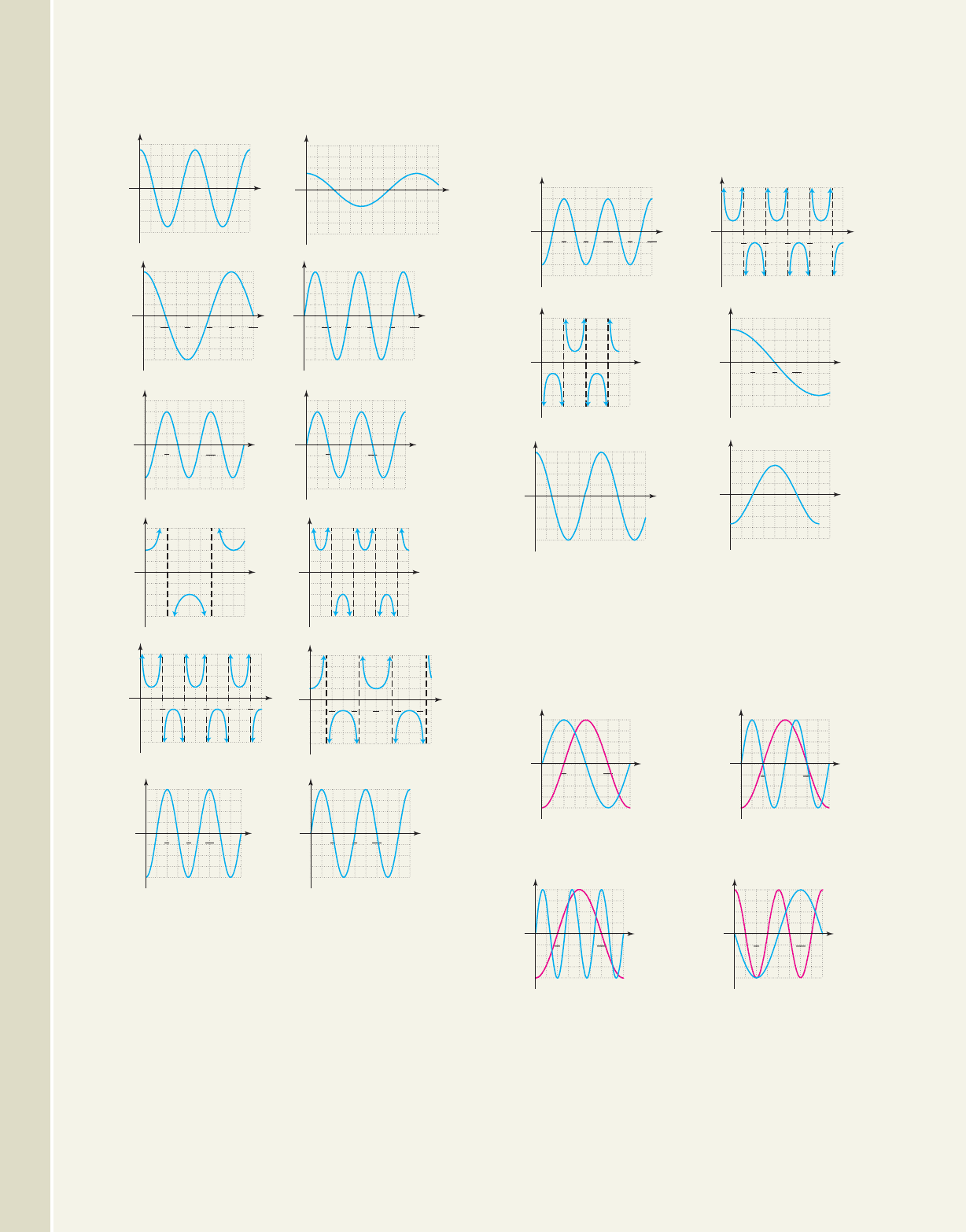
47. 48.
a. b.
c. d.
e. f.
g. h.
i. j.
k. l.
1
2
1
0
2
4
2
3
4
y
t
1
2
1
0
2
4
2
3
4
t
y
2
4
2
0
t
4
y
1
12
1
6
1
4
1
3
5
12
2
4
2
0
t
4
y
1
12
1
6
1
4
1
3
5
12
2
4
2
0
2 4 6 8
t
4
y
2
4
2
0
2 4 6 8
t
4
y
2
4
2
0
2
3
2
2
t
4
y
2
4
2
0
2
3
2
2
t
4
y
1
144
1
72
1
48
1
36
5
144
2
4
2
0
4
t
y
1
144
1
72
1
48
1
36
5
144
t
2
4
2
0
4
y
1
2
1
0
2
4 5 632
y
t
1
2
1
0
2
4 532
y
t
y 4 cos172t2y 4 sin1144t2
570 CHAPTER 5 An Introduction to Trigonometric Functions 5-68
The graphs shown are of the form cos(Bt) or
csc(Bt). Use the characteristics illustrated for
each graph to determine its equation.
49. 50.
51. 52.
53. 54.
Match each graph to its equation, then graphically
estimate the points of intersection. Confirm or
contradict your estimate(s) by substituting the values
into the given equations using a calculator.
55. 56.
57. 58.
1
2
1
0
3
2
2
2
1
2
1
x
y
1
2
1
0
2
3
2
2
x
2
y
y 2 sin1x2y 2 sin13x2
y 2 cos12x2;y 2 cos x;
0.5
1
0.5
0
2
3
2
2
x
1
y
0.5
1
0.5
0
2
3
2
2
1
x
y
y sin12x2y sin x
y cos x;y cos x;
1.2
0
2
t
1.2
y
3 4
6
0 12345
6
y
t
0.2
0.4
0.2
0
4
2
3
4
t
0.4
y
0.4
0.8
0.4
0
t
0.8
y
2 4 6
4
8
4
0
1
5
2
5
3
5
4
5
1
t
8
y
0.5
1
0.5
0
1
8
2
4
3
8
5
8
t
y
y A
y A
College Algebra & Trignometry—
cob19529_ch05_503-614.qxd 11/11/08 1:49 PM Page 570 epg HD 049:Desktop Folder:Coburn_do_t del-ch05:
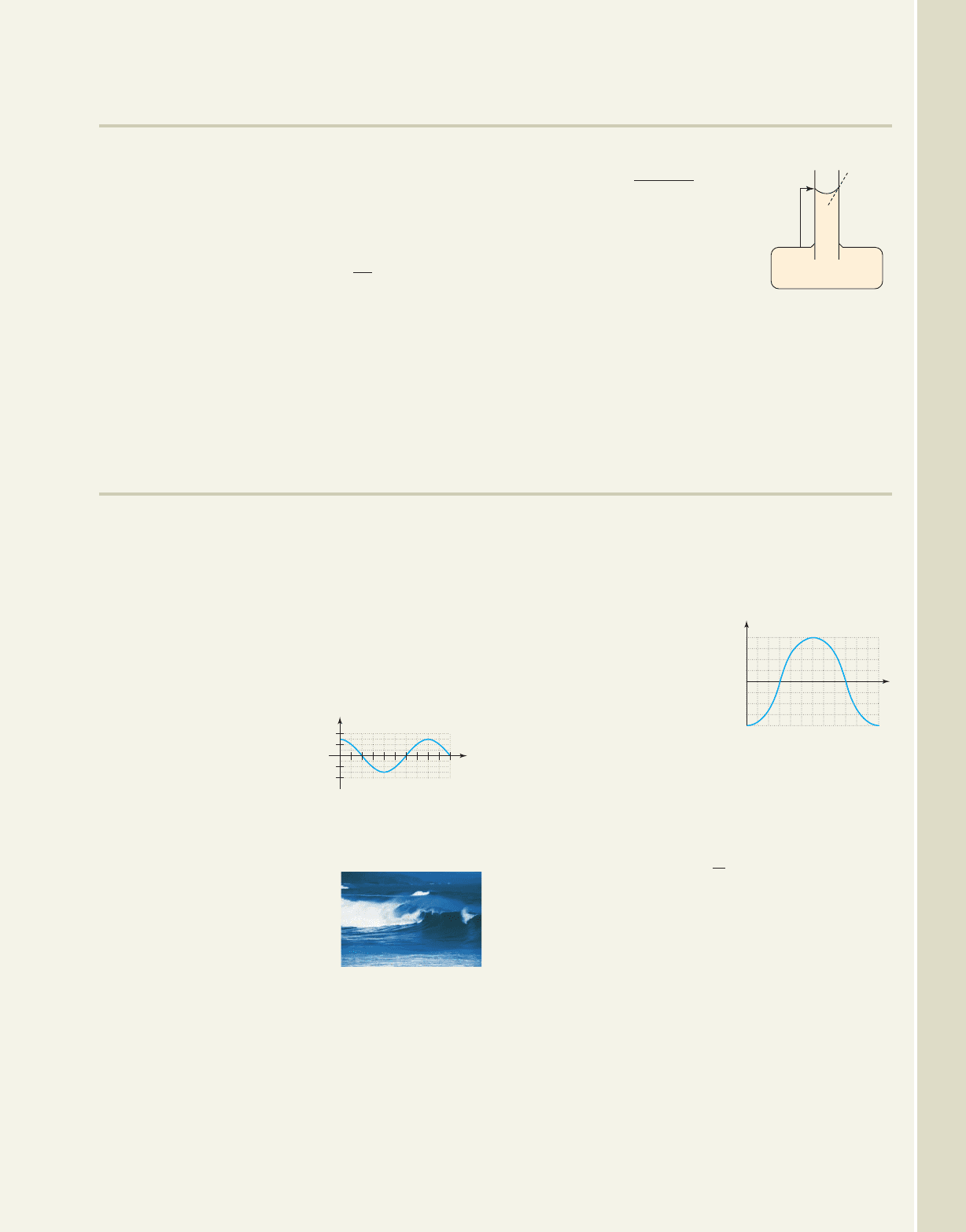
59. The Pythagorean theorem in trigonometric
form:
The formula shown is commonly known as a
Pythagorean identity and is introduced more
formally in Chapter 6. It is derived by noting that
on a unit circle, and while
Given that use the
formula to find the value of in Quadrant I.
What is the Pythagorean triple associated with
these values of x and y?
cos t
sin t
15
113
,x
2
y
2
1.
sin t y,cos t x
sin
2
cos
2
1
60. Hydrostatics, surface tension, and contact
angles:
The height that a liquid will
rise in a capillary tube is given
by the formula shown, where
r is the radius of the tube, is
the contact angle of the liquid
(the meniscus), is the surface
tension of the liquid-vapor film, and k is a constant
that depends on the weight-density of the liquid.
How high will the liquid rise given that the surface
tension , the tube has radius
the contact angle and
k 1.25?
22.5°,r 0.2 cm,
0.2706
y
2 cos
kr
5-69 Section 5.5 Graphs of the Sine and Cosine Functions; Cosecant and Secant Functions 571
WORKING WITH FORMULAS
y
Capillary
Tube
Liquid
APPLICATIONS
Tidal waves: Tsunamis, also known as tidal waves, are
ocean waves produced by earthquakes or other upheavals
in the Earth’s crust and can move through the water
undetected for hundreds of miles at great speed. While
traveling in the open ocean, these waves can be represented
by a sine graph with a very long wavelength (period) and
a very small amplitude. Tsunami waves only attain a
monstrous size as they approach the shore, and represent a
very different phenomenon than the ocean swells created by
heavy winds over an extended period of time.
61. A graph modeling a
tsunami wave is given in
the figure. (a) What is
the height of the tsunami
wave (from crest to
trough)? Note that is considered the level of
a calm ocean. (b) What is the tsunami’s
wavelength? (c) Find the equation for this wave.
62. A heavy wind is kicking up
ocean swells approximately
10 ft high (from crest to
trough), with wavelengths
of 250 ft. (a) Find the
equation that models these
swells. (b) Graph the equation. (c) Determine the
height of a wave measured 200 ft from the trough
of the previous wave.
h 0
Sinusoidal models: The sine and cosine functions are of
great importance to meteorological studies, as when
modeling the temperature based on the time of day, the
illumination of the Moon as it goes through its phases, or
even the prediction of tidal motion.
63. The graph given shows
the deviation from
the average daily
temperature for the hours
of a given day, with
corresponding to 6
A.M.
(a) Use the graph to
determine the related equation. (b) Use the equation
to find the deviation at (5
P.M.) and confirm
that this point is on the graph. (c) If the average
temperature for this day was what was the
temperature at midnight?
64. The equation models the height of
the tide along a certain coastal area, as compared
to average sea level. Assuming is midnight,
(a) graph this function over a 12-hr period.
(b) What will the height of the tide be at 5
A.M.?
(c) Is the tide rising or falling at this time?
t 0
y 7 sin
a
6
tb
72°,
t 11
t 0
2
1
20 40 60 80 100
Height
in feet
Miles
2
1
Temperature
deviation
2
4
2
0
4 8 12 16 20 24
t
4
College Algebra & Trignometry—
cob19529_ch05_503-614.qxd 11/11/08 1:49 PM Page 571 epg HD 049:Desktop Folder:Coburn_do_t del-ch05:
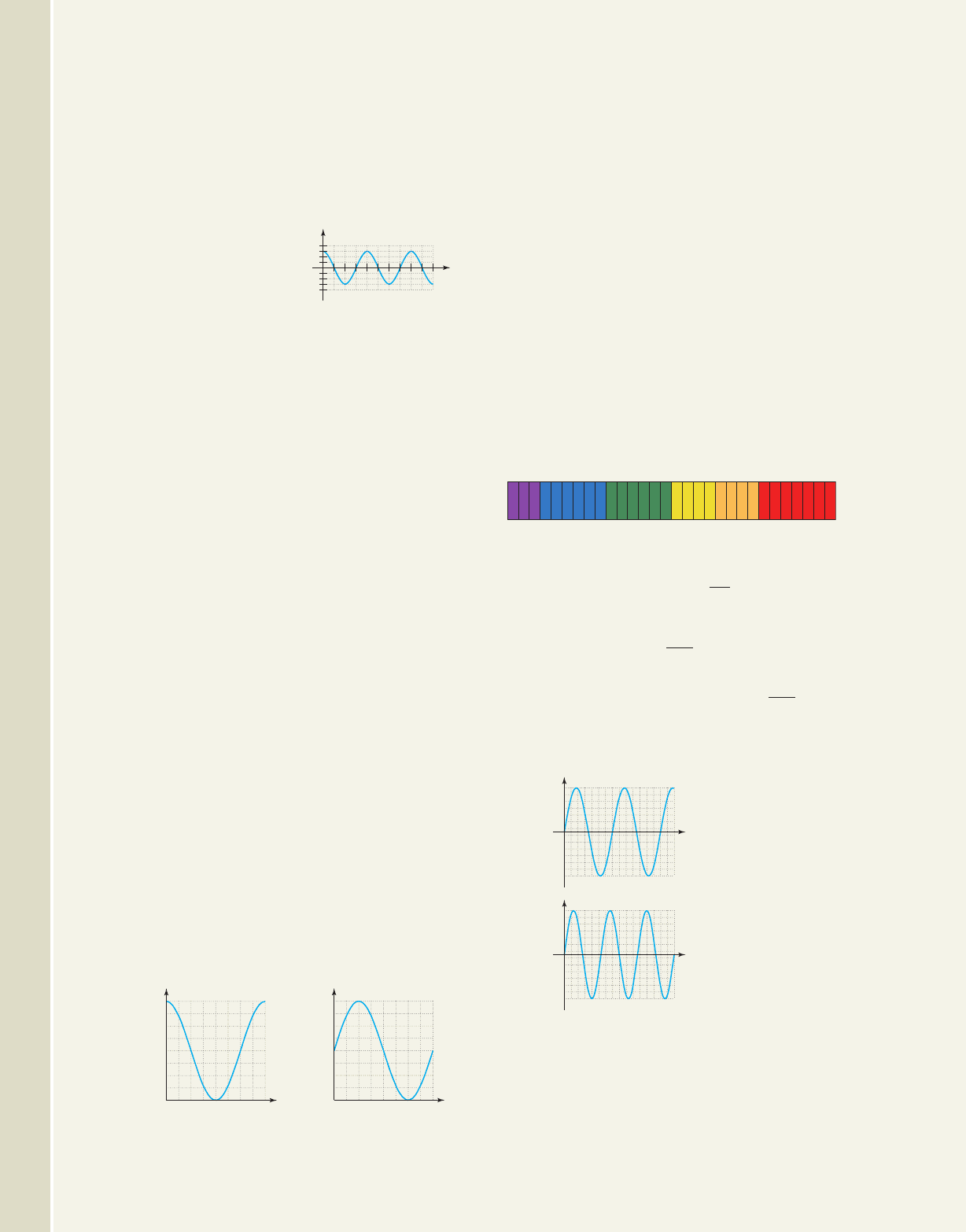
Sinusoidal movements: Many animals exhibit a wavelike
motion in their movements, as in the tail of a shark as it
swims in a straight line or the wingtips of a large bird in
flight. Such movements can be modeled by a sine or cosine
function and will vary depending on the animal’s size,
speed, and other factors.
65. The graph shown models
the position of a shark’s
tail at time t, as measured
to the left (negative) and
right (positive) of a
straight line along its length. (a) Use the graph to
determine the related equation. (b) Is the tail to the
right, left, or at center when sec? How far?
(c) Would you say the shark is “swimming
leisurely,” or “chasing its prey”? Justify your
answer.
66. The State Fish of Hawaii is the
humuhumunukunukuapua’a, a small colorful fish
found abundantly in coastal waters. Suppose the
tail motion of an adult fish is modeled by the
equation with d(t) representing
the position of the fish’s tail at time t, as measured
in inches to the left (negative) or right (positive)
of a straight line along its length. (a) Graph the
equation over two periods. (b) Is the tail to the
left or right of center at sec? How far?
(c) Would you say this fish is “swimming leisurely,”
or “running for cover”? Justify your answer.
Kinetic energy: The kinetic energy a planet possesses as it
orbits the Sun can be modeled by a cosine function. When
the planet is at its apogee (greatest distance from the Sun),
its kinetic energy is at its lowest point as it slows down and
“turns around” to head back toward the Sun. The kinetic
energy is at its highest when the planet “whips around the
Sun” to begin a new orbit.
67. Two graphs are given here. (a) Which of the graphs
could represent the kinetic energy of a planet
orbiting the Sun if the planet is at its perigee
(closest distance to the Sun) when ? (b) For
what value(s) of t does this planet possess 62.5% of
its maximum kinetic energy with the kinetic energy
increasing? (c) What is the orbital period of this
planet?
a. b.
25
0
50
75
100
12 48 60 72 84 96
t da
y
s
Percent of KE
24 36
25
0
50
75
100
12 48 60 72 84 96
t da
y
s
Percent of KE
24 36
t 0
t 2.7
d1t2 sin115t2
t 6.5
68. The potential energy of the planet is the antipode
of its kinetic energy, meaning when kinetic energy
is at 100%, the potential energy is 0%, and when
kinetic energy is at 0% the potential energy is at
100%. (a) How is the graph of the kinetic energy
related to the graph of the potential energy? In
other words, what transformation could be applied
to the kinetic energy graph to obtain the potential
energy graph? (b) If the kinetic energy is at 62.5%
and increasing [as in Graph 67(b)], what can be
said about the potential energy in the planet’s orbit
at this time?
Visible light: One of the narrowest bands in the
electromagnetic spectrum is the region involving visible
light. The wavelengths (periods) of visible light vary from
400 nanometers (purple/violet colors) to 700 nanometers
(bright red). The approximate wavelengths of the other
colors are shown in the diagram.
69. The equations for the colors in this spectrum have
the form where gives the length
of the sine wave. (a) What color is represented by
the equation ? (b) What color is
represented by the equation ?
70. Name the color represented by each of the graphs
(a) and (b) here and write the related equation.
a.
b.
Alternating current: Surprisingly, even characteristics of
the electric current supplied to your home can be modeled
by sine or cosine functions. For alternating current (AC),
the amount of current I (in amps) at time t can be modeled
by where A represents the maximum current
that is produced, and is related to the frequency at which
the generators turn to produce the current.
I A sin1t2,
1
0
300 600 900 1200
1
y
t (nanometers)
1
0
300 600 900 1200
1
y
t (nanometers)
y sin a
310
tb
y sina
240
tb
2
y sin1t2,
Violet Blue Green Yellow Orange Red
400 500 600 700
572 CHAPTER 5 An Introduction to Trigonometric Functions 5-70
20
10
1
Distance
in inches
t sec
20
10
2345
College Algebra & Trignometry—
cob19529_ch05_503-614.qxd 12/27/08 10:51 Page 572

71. Find the equation of the
household current
modeled by the graph,
then use the equation to
determine I when
sec. Verify that
the resulting ordered pair
is on the graph.
t 0.045
72. If the voltage produced by an AC circuit is
modeled by the equation
(a) what is the period and amplitude of the related
graph? (b) What voltage is produced when t 0.2?
E 155 sin1120t2,
5-71 Section 5.5 Graphs of the Sine and Cosine Functions; Cosecant and Secant Functions 573
30
15
30
15
Current I
t sec
1
50
1
25
3
50
2
25
1
10
EXTENDING THE CONCEPT
73. For and the
expression gives the average value of the
function, where M and m represent the maximum
and minimum values, respectively. What was the
average value of every function graphed in this
section? Compute a table of values for
and note its maximum and
minimum values. What is the average value of this
function? What transformation has been applied to
change the average value of the function? Can you
name the average value of by
inspection?
y 2 cos t 1
y 2 sin t 3,
M m
2
y A cos1Bx2,y A sin1Bx2
74. To understand where the period formula
came from, consider that if the graph of
completes one cycle from
to If completes
one cycle from to Discuss how
this observation validates the period formula.
75. The tone you hear when pressing the digit “9”
on your telephone is actually a combination
of two separate tones, which can be modeled
by the functions and
Which of the two functions
has the shortest period? By carefully scaling the
axes, graph the function having the shorter period
using the steps I through IV discussed in this section.
g1t2 sin32 114772t4.
f
1t2 sin3218522t4
Bt 2.Bt 0
B 1, y sin1Bt21t 2.1t 0
y sin1Bt2 sin11t2
B 1,
P
2
B
MAINTAINING YOUR SKILLS
76. (5.2) Given sin find an additional value
of t in that makes the equation
true.
77. (5.1) Use a special
triangle to calculate
the distance from the
ball to the pin on the
seventh hole, given
the ball is in a straight
line with the 100-yd
plate, as shown in the
figure.
sin t 0.930, 22
1.12 0.9,
78. (5.1) Invercargill, New Zealand, is at
south latitude. If the Earth has a radius of 3960 mi,
how far is Invercargill from the equator?
79. (1.4) Given and compute
the following:
a.
b.
c.
d.
z
2
z
1
z
1
z
2
z
1
z
2
z
1
z
2
z
2
2 5i,z
1
1 i
46°14¿24–
60
100 yd
100 yd
College Algebra & Trignometry—
Exercise 71
Exercise 77
cob19529_ch05_503-614.qxd 12/27/08 10:51 Page 573

Unlike the other four trig functions, tangent and cotangent have no maximum or
minimum value on any open interval of their domain. However, it is precisely this
unique feature that adds to their value as mathematical models. Collectively, the six
functions give scientists the tools they need to study, explore, and investigate a wide
range of phenomena, extending our understanding of the world around us.
A. The Graph of
Like the secant and cosecant functions, tangent is defined in terms of a ratio, creating
asymptotic behavior at the zeroes of the denominator. In terms of the unit circle,
which means in vertical asymptotes occur at and
, since the x-coordinate on the unit circle is zero (see Figure 5.68). We further note
when the y-coordinate is zero, so the function will have t-intercepts at
and in the same interval. This produces the framework for graphing
the tangent function shown in Figure 5.69.
Knowing the graph must go through these zeroes and approach the asymptotes,
we are left with determining the direction of the approach. This can be discovered by
noting that in QI, the y-coordinates of points on the unit circle start at 0 and increase,
while the x-values start at 1 and decrease. This means the ratio defining tan t is
increasing, and in fact becomes infinitely large as t gets very close to A similar
observation can be made for a negative rotation of tin QIV. Using the additional points
provided by and we find the graph of tan t is increasing
throughout the interval and that the function has a period of We also note
is an odd function (symmetric about the origin), since
as evidenced by the two points just computed. The completed graph is shown in
Figure 5.70 with the primary interval in red.
,
1
tan t
t
3
2
2
2
2
4
2
4
2
4
,
1
4
tan1t2tan ty tan t
.a
2
,
2
b
tan
a
4
b 1,tan a
4
b1
2
.
y
x
tan t
t
3
2
2
2
2
2
Asymptotes at
odd multiples of
t-intercepts at
integer multiples of
4
2
4
2
2t , 0, ,
tan t 0
3
2
t
2
,t
2
,3, 24,tan t
y
x
,
y tan t
574 5-72
5.6 Graphs of Tangent and Cotangent Functions
College Algebra & Trignometry—
Learning Objectives
In Section 5.6 you will learn how to:
A. Graph using
asymptotes, zeroes,
and the ratio
B. Graph using
asymptotes, zeroes,
and the ratio
C. Identify and discuss
important characteristics
of and
D. Graph
and with
various values of A and B
E. Solve applications of
and y cot ty tan t
y A cot1Bt2
y A tan1Bt2
y cot ty tan t
cos t
sin t
y cot t
sin t
cos t
y tan t
Figure 5.68
x
y
(x, y)
(1, 0)
(0, 0)
(0, 1)
t
(0, 1)
(1, 0)
x
y
tan t
Figure 5.69
Figure 5.70
cob19529_ch05_503-614.qxd 11/11/08 1:50 PM Page 574 epg HD 049:Desktop Folder:Coburn_do_t del-ch05:

5-73 Section 5.6 Graphs of Tangent and Cotangent Functions 575
The graph can also be developed by noting and
This gives by direct substitution and we can quickly complete a table of
values for tan t, as shown in Example 1. These and other relationships between the trig
functions will be fully explored in Chapter 6.
EXAMPLE 1
Constructing a Table of Values for
Complete Table 5.11 shown for using the values given for sin t and cos t,
then graph the function by plotting points.
tan t
y
x
f1t2 tan t
tan t
sin t
cos t
tan t
y
x
.cos t x,sin t y,
Table 5.11
t 0
010
101
tan t
y
x
13
2
12
2
1
2
1
2
12
2
13
2
cos t x
1
2
12
2
13
2
13
2
12
2
1
2
sin t y
5
6
3
4
2
3
2
3
4
6
Solution
For the noninteger values of x and y, the “twos will cancel” each time we compute
This means we can simply list the ratio of numerators. The resulting points are
shown in Table 5.12, along with the plotted points. The graph shown in Figure 5.71
was completed using symmetry and the previous observations.
y
x
.
Table 5.12
t 0
010
101
0 1 undefined 10
1
23
2323 1.7
1
23
0.58tan t
y
x
13
2
12
2
1
2
1
2
12
2
13
2
cos t x
1
2
12
2
13
2
13
2
12
2
1
2
sin t y
5
6
3
4
2
3
2
3
4
6
tan t
f (t)
2
2
2
4
4
t
2
2
3
2
, 0.58
6
, 1
4
, 1.7
3
, 0.58
5
6
, 1
3
4
, 1.7
2
3
Figure 5.71
Now try Exercises 7 and 8
College Algebra & Trignometry—
cob19529_ch05_503-614.qxd 11/11/08 1:50 PM Page 575 epg HD 049:Desktop Folder:Coburn_do_t del-ch05:
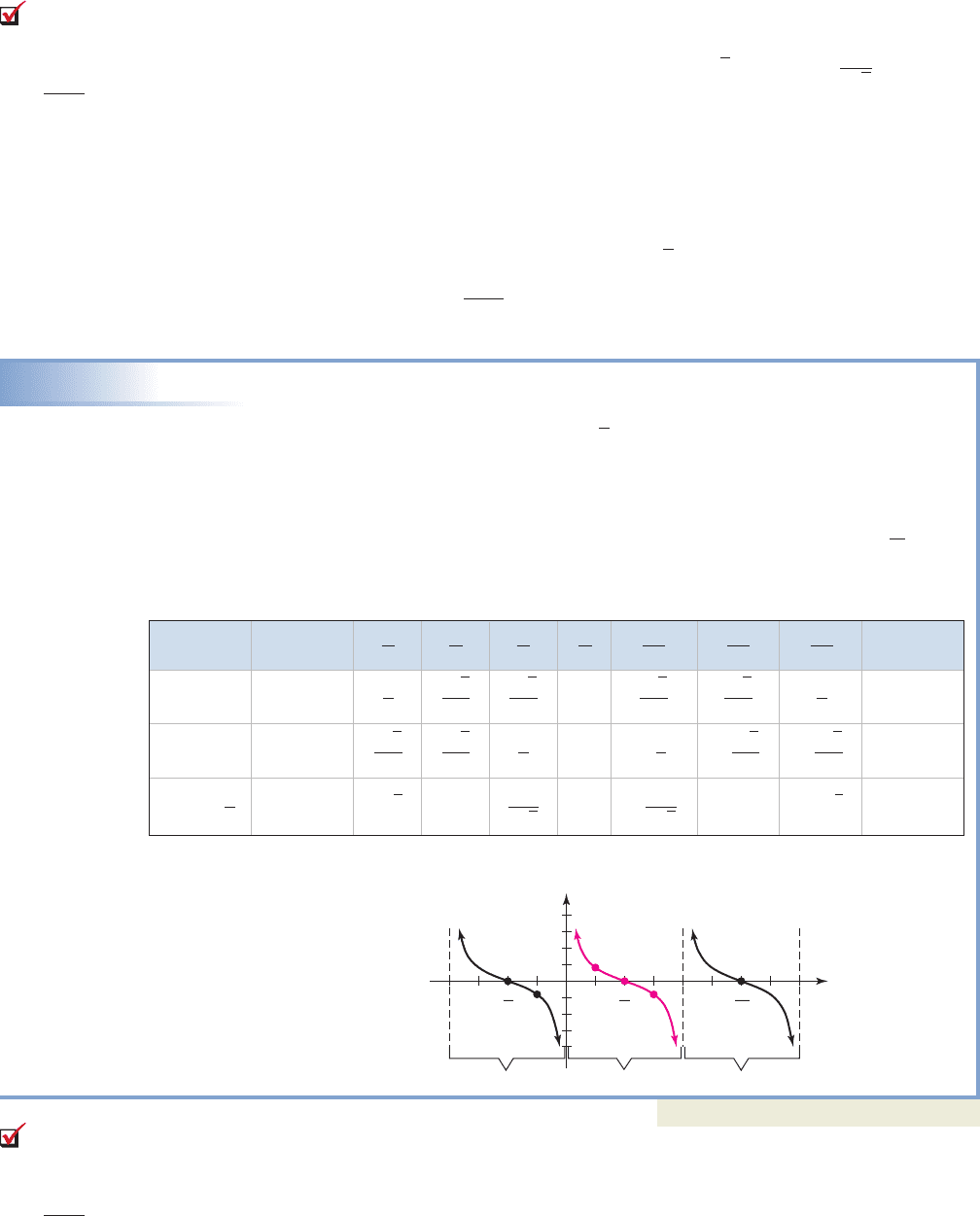
576 CHAPTER 5 An Introduction to Trigonometric Functions 5-74
Additional values can be found using a calculator as needed. For future use and
reference, it will help to recognize the approximate decimal equivalent of all special
values and radian angles. In particular, note that and See
Exercises 9 through 14.
B. The Graph of
Since the cotangent function is also defined in terms of a ratio, it too displays asymp-
totic behavior at the zeroes of the denominator, with t-intercepts at the zeroes of the
numerator. Like the tangent function, can be written in terms of
and and the graph obtained by plotting points.
EXAMPLE 2
Constructing a Table of Values for
Complete a table of values for for t in using its ratio relationship
with cos t and sin t. Use the results to graph the function for t in
Solution
The completed table is shown here. In this interval, the cotangent function has
asymptotes at 0 and since at these points, and has a t-intercept at since
The graph shown in Figure 5.72 was completed using the period P .x 0.
2
y 0
1, 22.
30, 4cot t
x
y
f1t2 cot t
cot t
cos t
sin t
,sin t y:
cos t xcot t
x
y
y cot t
1
13
0.58.13 1.73
A. You’ve just learned
how to graph using
asymptotes, zeroes, and the
ratio
sin t
cos t
y tan t
t 0
01 0
10 1
undefined 1 0 undefined23
1
1
23
1
23
23cot t
x
y
13
2
12
2
1
2
1
2
12
2
13
2
cos t x
1
2
12
2
13
2
13
2
12
2
1
2
sin t y
5
6
3
4
2
3
2
3
4
6
Now try Exercises 15 and 16
C. Characteristics of and
The most important characteristics of the tangent and cotangent functions are sum-
marized in the following box. There is no discussion of amplitude, maximum, or
minimum values, since maximum or minimum values do not exist. For future use and
y cot ty tan t
B. You’ve just learned
how to graph using
asymptotes, zeroes, and the
ratio
cos t
sin t
y cot t
cot t
t
3
2
2
2
2
4
2
4
2
Figure 5.72
College Algebra & Trignometry—
cob19529_ch05_503-614.qxd 11/11/08 1:50 PM Page 576 epg HD 049:Desktop Folder:Coburn_do_t del-ch05:

5-75 Section 5.6 Graphs of Tangent and Cotangent Functions 577
reference, perhaps the most significant characteristic distinguishing tan t from cot t is
that tan t increases, while cot t decreases over their respective domains. Also note that
due to symmetry, the zeroes of each function are always located halfway between the
asymptotes.
Characteristics of f(t) and f(t)
For all real numbers t and integers k,
Domain Range Asymptotes Domain Range Asymptotes
Period Behavior Symmetry Period Behavior Symmetry
increasing odd decreasing odd
EXAMPLE 3
Using the Period of to Find Additional Points
Given what can you say about and
?
Solution
Each value of t differs from by a multiple of
and Since the period of
the tangent function is all of these expressions have a value of
Now try Exercises 17 through 22
Since the tangent function is more common than the cotangent, many needed
calculations will first be done using the tangent function and its properties, then
reciprocated. For instance, to evaluate we reason that cot t is an odd
function, so Since cotangent is the reciprocal of tangent and
See Exercises 23 and 24.
D. Graphing and
The Coefficient A: Vertical Stretches and Compressions
For the tangent and cotangent functions, the role of coefficient A is best seen through
an analogy from basic algebra (the concept of amplitude is foreign to these functions).
Consider the graph of (Figure 5.73). Comparing the parent function withy x
3
y x
3
y A cot1Bt2y A tan1Bt2
cota
6
b13.tana
6
b
1
13
,
cota
6
bcota
6
b.
cota
6
b
1
13
.P ,
tana
5
6
b tana
6
b.tana
13
6
b tana
6
2b
tana
7
6
b tana
6
b,:
6
tan
a
5
6
b
tan
a
13
6
b,tan a
7
6
b,tan a
6
b
1
13
,
f1t2 tan t
cot1t2cot ttan1t2tan t
t k
1q, q2t kt
2
k1q, q2t
2
k
y cot ty tan t
cot t tan t
C. You’ve just learned how
to identify and discuss
important characteristics of
and y cot ty tan t
College Algebra & Trignometry—
cob19529_ch05_503-614.qxd 12/27/08 10:54 Page 577
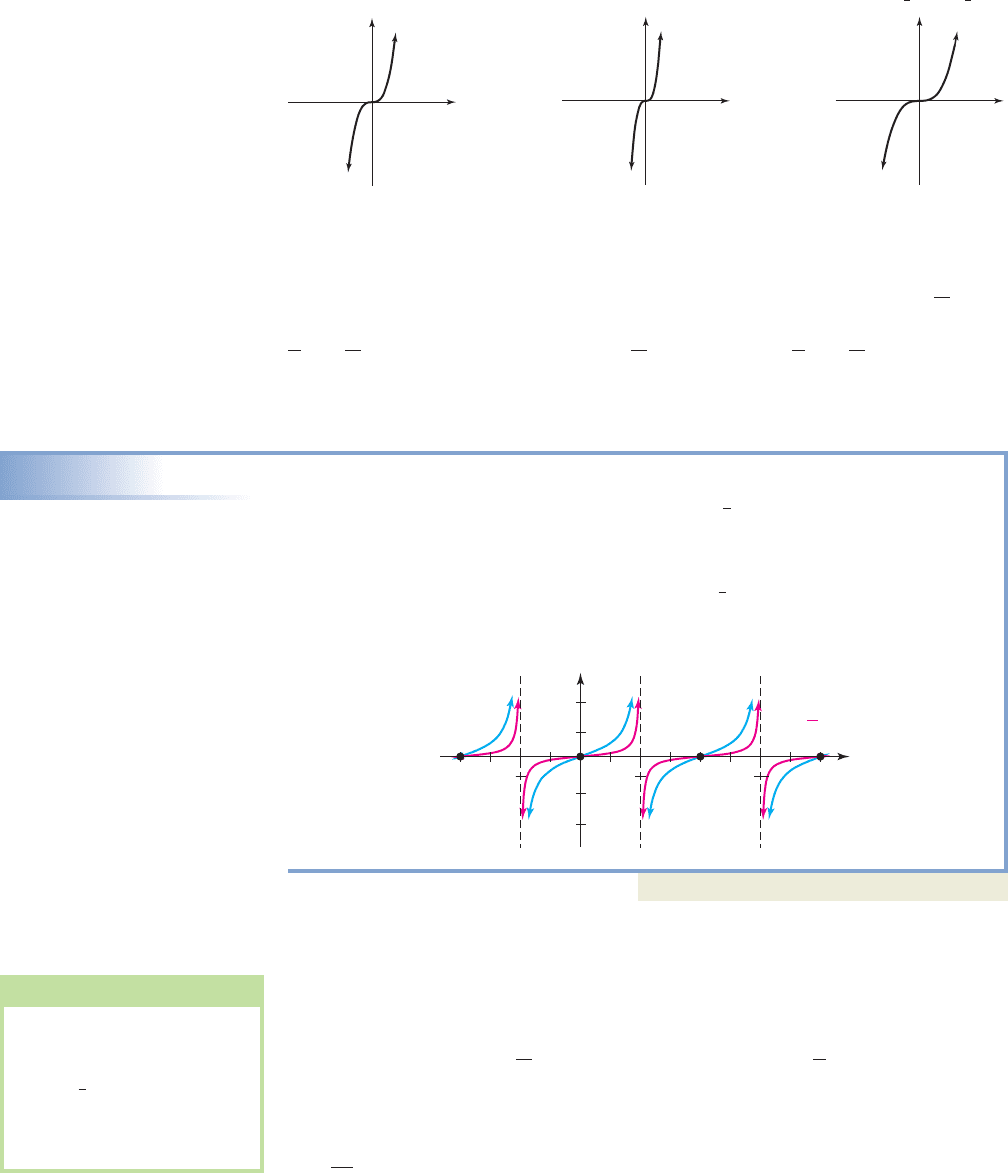
While cubic functions are not asymptotic, they are a good illustration of A’s effect
on the tangent and cotangent functions. Fractional values of A compress the
graph, flattening it out near its zeroes. Numerically, this is because a fractional part of
a small quantity is an even smaller quantity. For instance, compare with
To two decimal places, while so the
graph must be “nearer the t-axis” at this value.
EXAMPLE 4
Comparing the Graph of and
Draw a “comparative sketch” of and on the same axis and
discuss similarities and differences. Use the interval .
Solution
Both graphs will maintain their essential features (zeroes, asymptotes, period,
increasing, and so on). However, the graph of is vertically compressed,
causing it to flatten out near its zeroes and changing how the graph approaches its
asymptotes in each interval.
Now try Exercises 25 through 28
The Coefficient B: The Period of Tangent and Cotangent
Like the other trig functions, the value of B has a material impact on the period of the
function, and with the same effect. The graph of completes a cycle twice
as fast as while completes a cycle
one-half as fast
This reasoning leads us to a period formula for tangent and cotangent, namely,
where B is the coefficient of the input variable.P
B
,
1P 2 versus P 2.
y cota
1
2
tby cot t aP
2
versus P b,
y cot12t2
y
t
3
2
2
2
2
4
2
4
2
1
4
y tan t
y tan t
y
1
4
tan t
3, 24
y
1
4
tan ty tan t
g1t2 A tan tf1t2 tan t
1
4
tana
6
b 0.14,tana
6
b 0.57,
1
4
tana
6
b.
tana
6
b
1
A
6 12
578 CHAPTER 5 An Introduction to Trigonometric Functions 5-76
functions the graph is stretched vertically if (see Figure 5.74) and
compressed if In the latter case the graph becomes very “flat” near the
zeroes, as shown in Figure 5.75.
0 6
A
6 1.
A
7 1y Ax
3
,
x
y
x
y
x
y
Figure 5.73
Figure 5.74
Figure 5.75
y x
3
y 4x
3
; A 4 y
1
4
x
3
; A
1
4
WORTHY OF NOTE
It may be easier to interpret
the phrase “twice as fast” as
and “one-half as
fast” as . In each
case, solving for P gives the
correct interval for the period
of the new function.
1
2
P
2P
College Algebra & Trignometry—
cob19529_ch05_503-614.qxd 11/11/08 1:50 PM Page 578 epg HD 049:Desktop Folder:Coburn_do_t del-ch05:
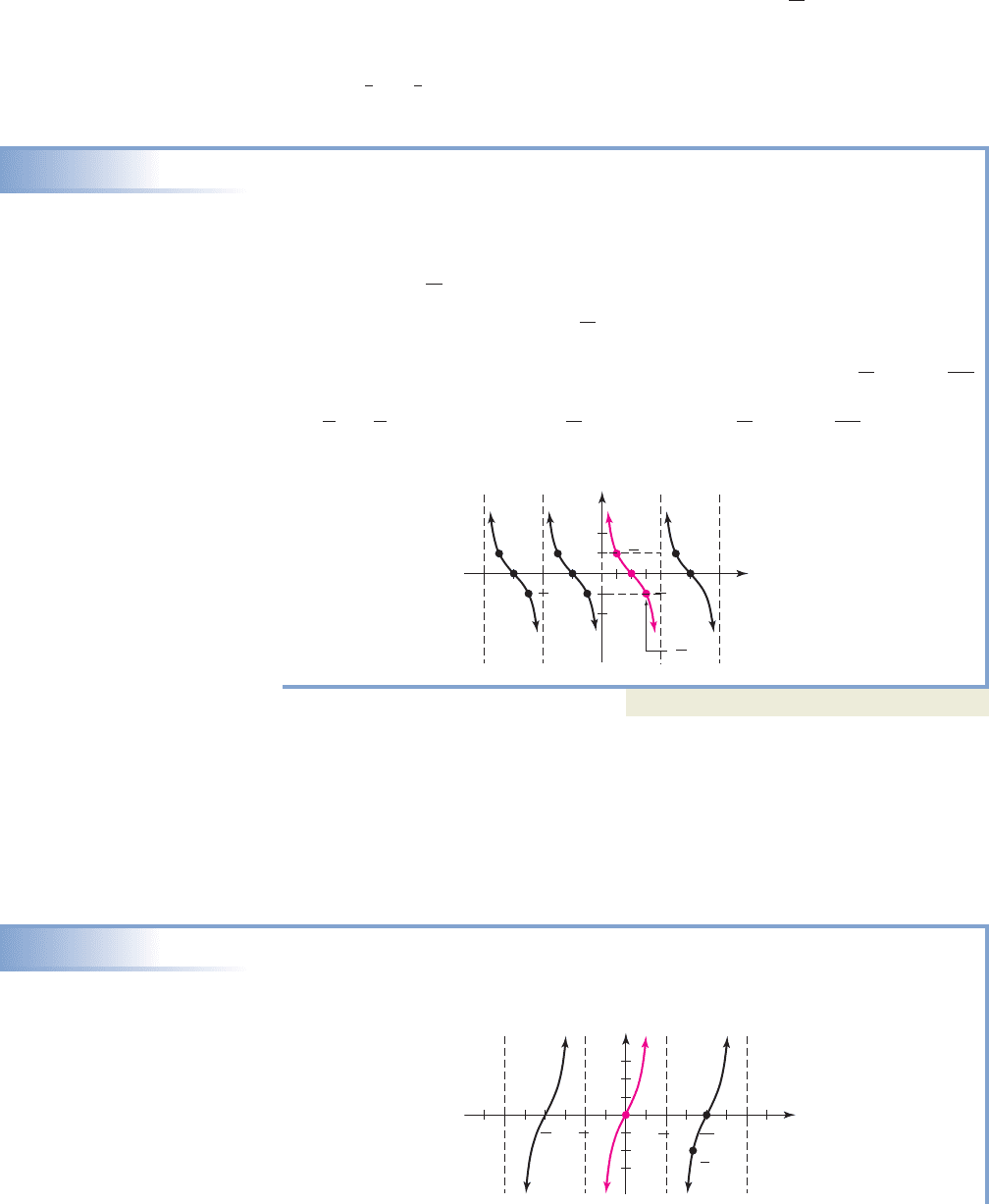
5-77 Section 5.6 Graphs of Tangent and Cotangent Functions 579
Similar to the four-step process used to graph sine and cosine functions, we can
graph tangent and cotangent functions using a rectangle units in length and 2A
units high, centered on the primary interval. After dividing the length of the rectangle
into fourths, the t-intercept will always be the halfway point, with y-values of occur-
ing at the and marks. See Example 5.
EXAMPLE 5
Graphing for
Sketch the graph of over the interval
Solution
For which results in a vertical stretch, and which
gives a period of The function is still undefined at and is asymptotic there,
then at all integer multiples of We also know the graph is decreasing, with
zeroes of the function halfway between the asymptotes. The inputs and
the and marks between 0 and yield the points and which
we’ll use along with the period and symmetry of the function to complete the graph:
Now try Exercises 29 through 40
As with the trig functions from Section 5.3, it is possible to determine the equa-
tion of a tangent or cotangent function from a given graph. Where previously we used
the amplitude, period, and max/min values to obtain our equation, here we first deter-
mine the period of the function by calculating the “distance” between asymptotes, then
choose any convenient point on the graph (other than a t-intercept) and substitute in
the equation to solve for A.
EXAMPLE 6
Constructing the Equation for a Given Graph
Find the equation of the graph, given it’s of the form
y A tan(Bt)
t
2
3
3
3
2
3
y
3
3
2
1
1
2
2
,
2
y A tan1Bt2.
y 3 cot(2t)
3
8
,
3
8
,
3
y
t
2
2
6
6
3
a
3
8
, 3b,a
8
, 3b
2
b
3
4
1
4
a
t
3
8
t
8
P
2
.
t 0
2
.
B
2y 3 cot12t2,
A
3
3, 4.y 3 cot12t2
A, B, 1y A cot1Bt2
3
4
1
4
A
P
B
College Algebra & Trignometry—
cob19529_ch05_503-614.qxd 12/27/08 10:54 Page 579
